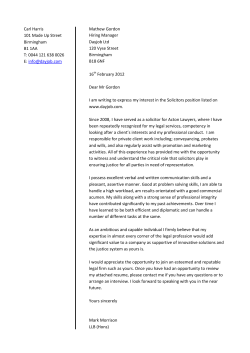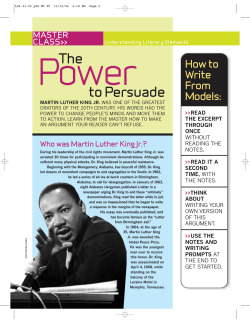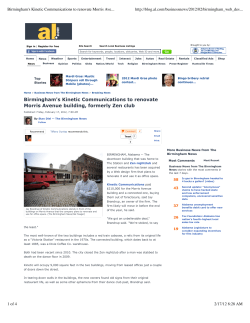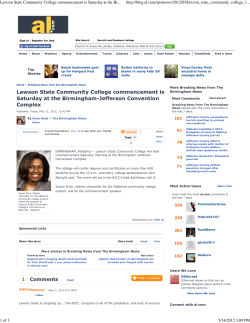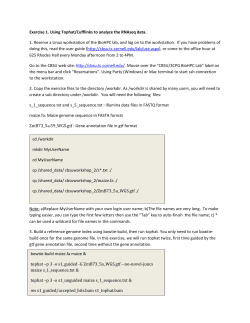
study guide
grades 9—12 Education SCHOOL-TIME SCREENINGS Study Guide Directed by Spike Lee BAM Rose Cinemas Wed, Oct 23 and Thur, Oct 24, 2013 Written by Abby Remer Brooklyn Academy of Music Peter Jay Sharp Building Department of Education and Humanities 30 Lafayette Avenue Brooklyn, New York 11217—1486 718.636.4130 Little TABLE OF CONTENTS Introduction 3 Unintentional Martyrs: Shattered Lives Destruction Inside and Out 4 Discovery Violence Ensues 5 The Nation Responds Enrichment Activities 6 Background: Birmingham, Apex of Segregation Why the 16th Street Baptist Church? 7 Enrichment Activities 8 News Media: A Force in History 9 Film as a Tool: Spike Lee’s 4 Little Girls Enrichment Activity 10 The Journey to Conviction Enrichment Activities 11 Sarah Collins Rudolph: The Forgotten Fifth Girl The Emotional Legacy For the Family and Friends: Does The Impact Linger? 12 Did the Civil Rights Movement Succeed? Enrichment Activities 13 Resources Welcome to the study guide for 4 Little Girls. This extraordinary piece of documentary filmmaking is a tribute to four young girls who were tragically murdered 50 years ago, on September 15, 1963. Director Spike Lee sensitively creates portraits of these children and the lives they led under the ever-present specter of racism. Through interviews with family members and eyewitnesses, as well as the use of period footage, Mr. Lee weaves a story that is at once heart-wrenching, unsentimental, infuriating, and prescient. Half a century after the bombing of the Sixteenth Street Baptist Church, this film presents an opportunity to reflect on the past and gauge how much progress has been made in the fight for civil rights and equality. YOUR VISIT TO BAM The BAM program includes this study guide, a pre-screening workshop in your classroom led by a BAM teaching artist, and a post-screening discussion at BAM. HOW TO USE THIS GUIDE This guide has been created to prepare you for your experience at BAM, to be used either before or after seeing the film. Developed specially for online viewing, the guide links to primary sources for further investigation. Students are encouraged to click on news headlines and embedded links to read articles from the time period, listen to music clips, and engage with the historical record of this seminal event. Every activitity includes associated Common Core standards, and primary source documents are rich with potential for further in-class learning. 2 · 4 LITTLE GIRLS STUDY GUIDE Unintentional Martyrs: Shattered Lives Church bomb felt like ‘world shaking’ —The Birmingham News Clock strikes 10:22am Deafening boom Shards fly. Walls crumble. Ceilings crash DEAD: Cynthia Wesley, 14 Denise McNair, 11 Carol Robertson, 14 Addie Mae Collins, 14 Destruction Inside & Out Piercing blast. Total darkness. What’s that smell, the taste in your mouth? Why can’t you see around you? Across from you is Reverend John H. Cross: “I jerked my head…and all around me was so much dust and soot—and glass had fallen, and plaster from the walls and ceiling…[I]t was so smoky in there that some of the people could hardly be identified three feet away.’’ “All of a sudden an explosion went off…It sounded like the whole world was shaking. And the building, I thought, was going to collapse.” —Reverend John Cross Right next to you, 15-year-old Carolyn Maull McKinstry says, “Someone shouted out, ‘Hit the floor’…Fear enveloped me. What is happening! For at least ten full seconds, no one moved. Nothing happened” Suddenly, chaos explodes. Everyone begins screaming, and stampeding. Scrambling out, you hear police and ambulance sirens blaring. As the clouds of dust roll down the street, you can make out people bruised, bleeding, and running in all directions. Others stand stock still, too stunned to move. Now fellow church members, families, and neighbors pour in and start clawing at the bricks, mortar, and piles of razor-sharp broken glass searching for loved ones. The blast crushed two nearby cars like toys and blew out windows blocks away. You hear a son telling a reporter, “We were riding through the area where the bomb went off going to the airport and momma was hit with a brick.” Glass flew at the Silver Sands cafe as the shock wave tore the windows and doors down. [Reuben] Ellis brushed glass off his lap and took a shard out of his arm. Blood flowed from both arms and the back of his head. —The Birmingham News 3 ·4 LITTLE GIRLS STUDY GUIDE DISCOVERY In the downstairs restroom, Reverend John Cross digs and “someone said, ‘I feel something soft,’ and we…discovered that it was a body, and pulled that one out, and dug a little deeper, and there was a second one, and a third one, and finally a fourth one…all thrown on top of each other.” “I pulled one of the large concrete blocks away and there was one of the girls…” — Parishioner, Moriss Marchal It’s the surviving fifth girl, 12-year-old Sarah Collins. Sarah says she and her sister Addie were in the restroom and “saw Cynthia, Denise, and Carole coming through the door. They spoke to us and went straight to…the other side. When they came out, I was standing over by the sink, washing my hands…All of a sudden, I heard a loud sound—BOOM!—and I was blind in both my eyes…I didn’t know what happened. I just remember calling ‘ADDIE, ADDIE, ADDIE.’” VIOLENCE ENSUES Angry Police Sift Blast Clues; Judge Decries Mockery Of Law —The Birmingham News 4 · 4 LITTLE GIRLS STUDY GUIDE Mayor Urges Citizens to Remain Calm —The Birmingham Post herald Victim by Victim, Scream by Scream —The Birmingham News ‘’It was like being in the vicinity of hell.’’ —Reverend John Cross “How could there be a bomb here in my church? I could hardly comprehend such a thought. I had heard bombs go off in my neighborhood, but it seemed unfathomable that it could happen in this safe haven.” — Carolyn Maull McKinstry, childhood friend of the four girls Unaware of what the men just found, you see hundreds of poeple coming toward you outside the church. In the background, you hear shotguns wildly blasting two blocks away as some furious African Americans stone cars. It takes the police two hours to break up the crowd. And in the midst of the confusion, there are carloads of white people circling the church, laughing and singing a little song: “Two, four, six, eight! We don’t want to integrate!” THE NATION RESPONDS Birmingham Bombing Kills 4 Negro Girls in Church; Riots Flare; 2 Boys Slain -THE NEW YORK TIMES The day after the bombing, President John F. Kennedy states, “If these cruel and tragic events can only awaken...this entire nation to a realization of the folly of racial injustice and hatred and violence, then it is not too late for all concerned to unite in steps toward peaceful progress before more lives are lost.” Staring up at the ceiling in bed that night, you hear sporadic gunshots as vigilantes attack African Americans on the street, raid their businesses, and set at least five fires. In the morning, you learn that two African-American boys, Virgil Ware and Johnny Robinson, have been killed. Sixteen-year old Johnny was shot in the back by a police officer. Next morning, as you’re walking to hear Dr. Martin Luther King, Jr.’s eulogy for the dead girls, you see 8,000 mourners, both African American and white, swaying together as they sing. We shall overcome, We shall overcome, We shall overcome someday. Deep in my heart, I do believe, We shall overcome some day. ENRICHMENT ACTIVITY Listen and Respond: The History of “We Shall Overcome” Listen to the fascinating origins of what became the unofficial anthem of the civil rights movement. Do you know any songs that were originally related to one event but used later for another? ENRICHMENT ACTIVITY Birmingham Sunday—The Power of Music Listen to the song “Birmingham Sunday.” Do the music and lyrics give you a different or deeper sense of the tragedy? Think about other songs you love. What is it about them that moves you the most? What makes them so effective? CCSS.ELA-Literacy.RI.11-12.1 Cite strong and thorough textual evidence to support analysis of what the text says explicitly as well as inferences drawn from the text, including determining where the text leaves matters uncertain. ENRICHMENT ACTIVITY A Dialogue of Music and Words Read and/or listen to Dr. Martin Luther King, Jr.’s entire powerful eulogy for the four girls and then listen to the famous Jazz musician John Coltrane’s “Alabama” He patterned it on the eulogy, and halfway through shifts from sorrow to gritty determination. 5 · 4 LITTLE GIRLS STUDY GUIDE Background: Birmingham, Apex of Segregation It was an awful time to grow up in this city. —Birmingham Resident What’s obvious about Birmingham’s nickname “Bombingham”? There were over 50 bombings in the 15 years leading up to the girls’ slaughter, and no arrests. While institutionalized bigotry was rampant throughout the South, Birmingham was the most deplorable example. The police either overtly supported or intentionally turned a blind eye the Ku Klux Klan’s extreme violence, and some were even Klan members themselves. Nobody was charged for the beating, shootings, burnings, and bombings of African-American businesses, homes, and churches. Police commissioner Eugene “Bull” Conner was known for his brutality, and repeatedly ordered his police, firemen, and sometimes Alabama state guards to let loose with tear gas, bully clubs, attack dogs, and fire hoses that blasted water which could tear the bark from trees 75 feet away. As elsewhere, Jim Crow laws (instituted in 1876), segregated African Americans, assigning them separate public movie theaters, restaurants, libraries, ballparks, buses, and trains. Signs ruled which fountains, bathrooms, and building entrances to use. In some states, it was illegal for African Americans to greet white people. The state’s governor, George Wallace, was a self-acknowledged racist who proclaimed in his January inauguration speech, “Segregation now! Segregation tomorrow! Segregation forever!” 6 · 4 LITTLE GIRLS STUDY GUIDE Why the 16th Street Baptist Church? The bombers chose the 16 Street Baptist Church for a specific reason. Given Birmingham’s climate of rabid racism, local activists brought Dr. Martin Luther King, Jr. in to help design a campaign of non-violent confrontation to end discrimination, and used the 16th Street Baptist Church as their staging ground. In the beginning, they staged boycotts, sit-ins and protests, but the white business leaders refused to budge on desegregating the city’s public facilities, theaters, restaurants, and stores, or to hire African Americans. But Birmingham’s civil rights campaign leaders realized they needed more people and a new method if they were going to make any real impact. Some of the adults were reluctant—they were afraid to lose their jobs and not able to support their families. So the organizers decided to recruit a whole new group of people to help: youth. The Children’s Crusade Imagine yourself with other high school students in a huge march to get everyone’s attention, and put pressure on the business leaders of Birmingham. The march’s first day, May 2nd, isn’t so bad. Row after row of you determinedly march out of the 16th Street Baptist Church. Bull Connor immediately arrests the first 50 for not have a permit,” so another 50 of you run out laughing, clapping, and singing, “Freedom! Freedom!” The arrests continue, and you hear that Bull Connor has locked up 700 children and young people. Undaunted, you and a thousand others show up the next day. Then things get terrifying. Shirley Wesley King, Cynthia’s sister, recalls when Conner let lose men with fire hoses: “They were literally washing children down the street.” Carolyn M. McKinsktry says, “It was like a brick water cannon…I don’t know if anyone’s thought about the pressure of one of those hoses, but it was like being whipped. It hit me in the face…and took my hair off.” Carolyn Maull McKinstry remembers, “When we reached the church, I stopped and stared. There were white tanks filling Birmingham’s bustling streets. Army tanks!... Bull Connor ran all around us screaming into his megaphone. ‘Blast them with water!’…Water shot out at a hundred pounds of pressure per second— hard enough to break bones…The restless dogs charged at anyone close by, grabbed children’s arms and legs, bit their stomachs, ripped flesh, and drew significant blood.” You escape the panic but 2,000 children and 500 adults are arrested. The day’s horror does, however, finally elicit results. A week later, under pressure from the United States Justice Department, Birmingham’s white city officials agreed to desegregate the stores and hire African Americans. Watch: Gripping Coverage of Children’s March! But a day before the 16th Street Church killings, Alabama Governor George Wallace virtually endorses bloodshed, bluntly declaring in his refusal to desegregate, saying “What we need is a few first class funerals.” 7 · 4 LITTLE GIRLS STUDY GUIDE ENRICHMENT ACTIVITY Do People Change? How Much? Overview Read the chronological series of Alabama George Wallace’s quotes Does he change over time? To what degree? Identify specific examples to back up your opinions. CCSS.ELA-Literacy.R11-12.1 Cite strong and thorough textual evidence to support analysis of what the text says explicitly as well as inferences drawn from the text, including determining where the text leaves matters uncertain. ENRICHMENT ACTIVITY Do Important Events In History Happen In Isolation? Read Change Blowing in Wind During ‘63 Learn more details about the atmosphere and events leading up to the bombing. Then think about something important that has happened in the news recently. What other events or attitudes might have contributed to that recent piece of news? CCSS.ELA-Literacy.RI.11-12.1 Cite strong and thorough textual evidence to support analysis of what the text says explicitly as well as inferences drawn from the text, including determining where the text leaves matters uncertain. News Media: A Force In History How do you know what’s going on around you—social media? The 24-hour news cycle? In the 1960s, people got breaking news through the daily papers, or nightly television and radio shows. When the national media began to increasingly write about the civil rights struggle, the movement gained traction. People across the entire county started to become aware of what African Americans were truly facing. As a result, the movement’s leaders planned events that they hoped would bring widespread coverage. Sadly, the 16th Street Baptist Church bombing became a huge national story exactly because it killed four innocent children. Across the country, news headlines of the ghastly bombing moved many people out of complacency. Outrage erupted, and telegrams flooded the White House. I don’t think the white community understood the depth of the problem and the depth of the hate…until that incredibly mean-spirited, terrible crime of blowing up kids in a Sunday School basement…[now] Americans understood the nature of that hate that was preventing integration particularly in the South, but also throughout America. —Walter Cronkite Think About It: Who Writes the First Draft of History? Journalists are on the front lines of breaking news, trying to make sense of events as they evolve. Sometimes facts are wrong or conflict among the different articles. But in choosing what to tell us and how, the news media contributes to the construction of history. Listen to details at “How The Civil Rights Movement Was Covered In Birmingham” Think About It: “Killers of the Innocents” History is not black and white, and generalizations are always a danger. Not all white southerners were racists, and not all white northerners embraced African Americans. So what might surprise you about the excerpt below, from “Killers of the Innocents,” a commentary in The Birmingham World newspaper three days after the bombing? How does it affect your understanding of the complexities of history? “Society in a free country has a solemn responsibility to itself and those who make it up. Free men are bound by an irrevocable civic contract to safeguard the rights, safety, and security of all of its members. This is the basic issue in what is happening in Birmingham. The continued unsolved racial bombings tend to suggest the deterioration of society in this city…Is Birmingham a sick city…The killers of the innocents have challenged the conscience of decent person everywhere.” 8 · 4 LITTLE GIRLS STUDY GUIDE Film as a Tool: Spike Lee’s 4 Little Girls In 1983, Spike Lee, was captivated by the fascinating, intricate article, “The Birmingham Bombing,” in The New York Times magazine.The story offers in-depth insight into the 16th Street Baptist Church bombing, the context in which it occurred, and the complex path of trying to lock away the bombers. Spike Lee asked Chris McNair, the father of Denise McNair, if he would participate in making a film about the bombing. Spike Lee, however, was an unknown film student and lacked the skills necessary to make such a documentary and the idea did not come to fruition. Ten years later, Lee was a recognized director and Chris McNair agreed. “Finally I found someone whom I could trust… If I didn’t feel confident, I wouldn’t have talked with him. It’s very important that this be done accurately and correctly.” By this point, McNair was a wellrespectedpublic figure, and had been a legislator for some 20 years; once he was on board, the families of the other victims followed. “I don’t want people to ever forget...If there’s one thing I want people to get from this, it is that violence doesn’t pay. We all live in this small place—the world, together and we need to figure out a way to coexist.” — Chris McNair, Denise’s father ENRICHMENT ACTIVITY Screening the FIlm Every documentarian presents a story with a personal point of view. When you watch Spike Lee’s 4 Little Girls look for what factual information Lee chose to use. Notice what the original source of this information is. Also, pay attention to the filmic techniques he uses: camera angles, music cues, editing cuts. How do all these choices influence the way you understand and think about the bombing, the girls’ deaths, Birmingham, and the civil rights movement? CCSS.ELA-Literacy.RI.11-12.1 Cite strong and thorough textual evidence to support analysis of what the text says explicitly as well as inferences drawn from the text, including determining where the text leaves matters uncertain. CCSS.ELA-Literacy.SL.11-12.4 Present information, findings, and supporting evidence, conveying a clear and distinct perspective, such that listeners can follow the line of reasoning, alternative or opposing perspectives are addressed, and the organization, development, substance, and style are appropriate to purpose, audience, and a range of formal and informal tasks 9 · 4 LITTLE GIRLS STUDY GUIDE The Journey to Conviction Were the killers ever brought to justice? It took 39 years in fits and starts to get three of the four. Many of the relatives didn’t live to see one or more of the bombers convicted. But before journeying down the long tangled, legal road to convictions, let’s reconnect to the heart of the event, with a poignant conversation between a mother and daughter in “ The Ballad of Birmingham.” FBI files, released decades after the bombing, revealed that the Bureau had testimony from relatives, former Klansmen, eye witnesses, and secret recordings that indicated the men were guilty. As early as 1965, a Birmingham field officer had written to FBI Director J. Edgar Hoover reporting that “no avenue of investigative activity has been overlooked…As a result, it is apparent that the bombing was planned by former Klansmen Robert E. Chambliss, Bobby Frank Cherry, Herman Frank Cash, Thomas E. Blanton, Jr.” and, furthermore, reassured Hoover that there was a ‘’climate of public opinion favoring prosecution” despite the city’s all-white jury system. But Hoover opposed the civil rights movement, and wrote back that he believed there was too “remote” of a chance of getting a conviction, slamming the FBI case down. The bombers roamed free and the authorities lied to the parents, explaining that although they knew who the killers were, they didn’t have any witnesses who would testify, when in fact, they did. ENRICHMENT ACTIVITY What Went Wrong? Dissect and identify the key obstacles identified by the 1983 New York Times article “The Birmingham Bombing” in the lengthy path to three convictions. From everything you know now, what is your opinion on the official summary “A Byte Out of History” by the FBI about its conduct in the investigation? CCSS.ELA-Literacy.RI.11-12.1 Cite strong and thorough textual evidence to support analysis of what the text says explicitly as well as inferences drawn from the text, including determining where the text leaves matters uncertain. CCSS.ELA-Literacy.RI.11-12.1 Cite strong and thorough textual evidence to support analysis of what the text says explicitly as well as inferences drawn from the text, including determining where the text leaves matters uncertain. “Chambliss was the most pathological racist I have encountered. He was a chilling character.” —Howell Raines, former Executive Director of The New York Times 10 · 4 LITTLE GIRLS STUDY GUIDE Bob Chambliss was the first bomber to be tried for the crime. His stepdaughter and granddaughter reported instances of him proudly boasting about his involvement in the bombing. But it was Chambliss’ niece, Elizabeth H. Cobbs, who provided the most important information. She testified that the day before the bombing, Chambliss, angry about a local newspaper article about a white girl reportedly attacked by an African-American, “placed his hands on the newspaper [and] looked me in the face and said, ‘Just wait till after Sunday morning, and they will beg us to let them segregate.’ I asked him what he meant and he said, ‘Just wait and see,” was his reply. Herman Frank Cash died in 1994 without ever going to trial. In 2001, 38 years after the killings, Thomas Blanton was given four life terms. He passed away three years later. Robert Cherry died just two years after his guilty verdict in 2002. “Ex-wife Says Suspect Admitted Role In 1963 Birmingham Church Bombing” —Newhouse News Service, Thur, Jul 22, 1999 ENRICHMENT ACTIVITY So What’s the Story Be a contemporary journalist and develop a gripping social-media broadcast pulling from some of the primary source articles in the links below Be aware of conflicting details, and particular points of view. Civil Rights Digital Library AL.COM Everything Birmingham “Special report: Sixteenth Street Church Bombing” FBI original files: “Birmingham 16th street Baptist church bombing” Selected Articles from Multiple Sources CCSS.ELA-Literacy.RI.11-12.7 Integrate and evaluate multiple sources of information presented in different media or formats (e.g., visually, quantitatively) as well as in words in order to address a question or solve a problem. Sarah Collins Rudolph: The forgotten Fifth Girl What about Sarah Collins, Junie and Addie’s sister, who against all odds survived in the bathroom? Sarah remains emotionally and physically damaged. Despite months of hospital and surgeries, she lost her right eye. She only gained foggy vision in the other eye. But today her glaucoma could blind her completely. Sarah also still carries fragments in her chest and abdomen that also were too dangerous to remove. People told her to “just get over it.” But, as she puts it, “I went through the worst thing I think any child could ever go through, and I’ve still got the scars. …I still shake. I still jump when I hear loud sounds…Everyday I think about it, just looking in the mirror and seeing the scars on my face. I’m reminded of it every day.” Over the past 50 years, Sarah has been left out of many commemorations for the other girls and few know her story at all. And unlike the other families, she never received and is still denied any monetary compensation, leaving her to struggle with serious medical costs. “Long Forgotten 16th Street Baptist Church Bombing Survivor Speaks Out”Hear Sarah in her own powerful words. The Emotional Legacy For the Family and Friends: Does The Impact Linger? As a relative or friend of Denise, Addie, Cynthia, or Carolyn, how might you feel now after 50 years? Carolyn’s mother, Alpha Robertson, says, “We had good friends and family that gave us a lot of support…The hating of people wasn’t going to do me any good. It would hurt me worse than it would them…It comes up every now and then, but I’ve tried to put all that behind me.” Carolyn’s father never recovered from her death. You saw Junie Collins, Addie’s sister, break down in the film saying, “It affected me so bad.” She’d had to identify Addie’s ravaged body when she was only 16 years old. Junie suffered severe stress, nervous breakdowns, and electric-shock treatments that merely increased her memories rather than erase them. There were two others killed the night of the bombing. The policeman who shot Johnny Robinson in the back without prior verbal warning as he was trying to run away, was never tried despite eyewitnesses to the murder. Years later, after the officer had died and couldn’t be tried, Johnny’s brother described the FBI finally coming “to our house and sit down to tell us what happened. They didn’t tell us while my mama was living.” She spent time a psychiatric hospital after her son’s death. (For more see “Johnny’s Death: The Untold Tragedy in Birmingham”) 11 · 4 LITTLE GIRLS STUDY GUIDE Photo of Alpha Robertson courtesy HBO, by David Lee Did the Civil Rights Movement Succeed? Did the girls die in vain? Did Dr. Martin Luther King, Jr.’s “dream” come true? Some feel that the girls’ deaths shifted the climate across the nation, allowing President Johnson to secure passage of the Civil Rights Act of 1964 and prohibit discrimination in accommodations, facilities, education, employment, and public places. There were many momentous events before and after the bombing. After the Civil Rights and Voting Acts, leaders shifted their focus to the problems of poverty, equal employment, and housing. Unfortunately, economic disparity increased during 1970s and 1980s, and activists had to fight to retain previous gains or ensure enforcement of those supposedly won. For African Americans and many other minorities today, race is still an issue, socially, politically, economically, and educationally. Currently, New Yorkers are dealing with “stop-and-frisk” policies and racial profiling, not just of African Americans but Muslims, Hispanics, and others as well. Alarmingly, after almost 50 years, the 1965 Voting Rights Act is under attack, and now restrictions are unfairly striking the poor, elderly, and minorities the hardest. Still, the civil rights movement served as an inspiring model for future liberation movements of women, gays and lesbians, Native Americans, and others. Some groups have achieved more than others, but the situation for many has moved forward. ENRICHMENT ACTIVITY Who Can Vote Now? Objective Investigate the controversy over the 1965 Voting Rights, which prohibits the denial, restriction or discrimination of the right to vote. Design a series of protest posters with others that lays out why it affects the elderly, minorities, and those with little education or in poverty the most. CCSS.ELA-Literacy.RI.11-12.1 Cite strong and thorough textual evidence to support analysis of what the text says explicitly as well as inferences drawn from the text, including determining where the text leaves matters uncertain. CCSS.ELA-Literacy.RI.11-12.8 Delineate and evaluate the reasoning in seminal U.S. texts, including the application of constitutional principles and use of legal reasoning (e.g., in U.S. Supreme Court majority opinions and dissents) and the premises, purposes, and arguments in works of public advocacy (e.g., The Federalist, presidential addresses). 12 · 4 LITTLE GIRLS STUDY GUIDE ENRICHMENT ACTIVITY Do You Have the Right to Be Passive? Look around you. Where does racism, prejudice, discrimination, or inequality still exist socially, politically, economically, or educationally? Use the creative power of music, visual art, film, drama, opera, dance, prose, poetry, fiction, and multimedia to convince us to help those who are faced with injustice. Make your contribution to creating history, charting where we go from here. CCSS.ELA-Literacy.SL.11-12.2 Integrate multiple sources of information presented in diverse formats and media (e.g., visually, quantitatively, orally) in order to make informed decisions and solve problems, evaluating the credibility and accuracy of each source and noting any discrepancies among the data. CCSS.ELA-Literacy.WHST.11-12.1a Introduce precise, knowledgeable claim(s), establish the significance of the claim(s), distinguish the claim(s) from alternate or opposing claims, and create an organization that logically sequences the claim(s), counterclaims, reasons, and evidence. RESOURCES FURTHER EXPLORATION Online Resources Public Television & Radio Online Websites NPR Special Series: The Summer of 63’ PBS: “Eyes on the Prize” Comprehensive website of America’s Civil Rights Movement from 1945-1985 Film, Poetry, Prose, Plays And Music “Shake, Rattle And Rally: Code Songs Spurred Activism In Birmingham” “The Mix: Songs Inspired By The Civil Rights Movement” Lyrics of Freedom Songs “Soundtrack for a Revolution” is a window into the musical and lyrical soul of civil rights movement, as well as the men and women that used song to give them the strength and solidarity to stand up for justice in the face of staunch, often violent injustice and bigotry. These songs and chants of freedom, sung by protestors, activists, and civil rights leaders during the 1950s and 1960s. Examples of Film, Poetry, Prose, Plays And Music Additional online Resources Civil Rights Digital Library Ferris State University: Jim Crow Museum of Racist Memorabilia “Using Objects of Intolerance to Teach Tolerance and Promote Social Justice” Library of Congress Guides for Analyzing Primary Resources Library of Congress Guides for Using Primary Resources: Motion Pictures, Photographs, Sound Recordings, Sheet Music and Songs, Political Cartoons, Prints, Oral Histories Manuscripts Related Movies About Racial Discrimination In the Heat of the Night An African American police detective is asked to investigate a murder in a racially hostile southern town. Sidney Poitier, Rod Steiger, Warren Oates Guess Who’s Coming to Dinner Matt and Christina Drayton are a couple whose attitudes are challenged when their daughter brings home a fiancé who is black. Spencer Tracy, Sidney Poitier, Katharine Hepburn Gentlemen’s Agreement Philip Green is a highly respected writer who is recruited by a national magazine to write a series of articles on anti-Semitism in America. He’s not too keen on the series, mostly because he’s not sure how to tackle the subject. Then it dawns on him: if he was to pretend to all that he was Jewish, he could then experience the degree of racism and prejudice that exists and write his story from that perspective. Book Carolyn Maull McKinstry, “While the World Watched” (2011), provides an eyewitness account from a childhood friend of the four girls about the bombing, the events leading up to it, and the climate and life at that time in Birmingham. 13 · 4 LITTLE GIRLS STUDY GUIDE Title sponsor of BAM Rose Cinemas & BAMcinematek: Major support for BAM Education programs provided by: BAM Education & Humanities The mission of BAM Education & Humanities is to ignite imagination and ideas. Through programs that enrich the audience experience, spark conversation, and generate creative engagement, we turn the light on for curious minds. BAM Education connects learning with creativity, engaging imagination by encouraging self-expression through in- and after-school arts education programming, workshops for students and teachers, school-time performances, and comprehensive school-break arts programs. Leadership support for BAM Education Programs is provided by The Irene Diamond Fund. Expansion of BAM’s Community and Education Programs made possible by the support of The SHS Foundation. Leadership support for school-time performances, pre-show preparation workshops, and educational film screenings is provided by The Simon and Eve Colin Foundation, Inc. and Lemberg Foundation. Leadership support for educational film screenings and Brooklyn Reads is provided by Goldman Sachs Gives at the recommendation of David and Susan Marcinek. Development of new education and community initiatives at the BAM Fisher supported by Altman Foundation; Brooklyn Community Foundation; The Simon & Eve Colin Foundation; Rockefeller Brothers Fund; and The Skirball Foundation. Education programs at BAM are supported by: Jody and John Arnhold; Barker Welfare Foundation; Tiger Baron Foundation; The Bay and Paul Foundations; Constans Culver Foundation; The Corinthian Foundation; The Della Rosa Family Foundation; Judith and Allan Fishman; William and Mary Greve Foundation; Charles Hayden Foundation; The Rita and Alex Hillman Foundation; Jaharis Family Foundation; Emily Davie and Joseph S. Kornfeld Foundation; David and Susan Marcinek; National Grid; Tony Randall Theatrical Fund; Tracey and Phillip Riese; The Jerome Robbins Foundation, Inc.; The David Rockefeller Fund; Martha A. and Robert S. Rubin; May and Samuel Rudin Family Foundation; In Memory of Robert Sklar; Sills Family Foundation; Sam and Ellen Sporn; Surdna Foundation; The Alvin and Fanny B. Thalheimer Foundation; Travelers Foundation; Michael Tuch Foundation; Turrell Fund; and Joseph LeRoy and Ann C. Warner Fund. Education programs at BAM are endowed by: Lila Wallace-Reader’s Digest Endowment Fund for Community, Educational, & Public Affairs Programs; Martha A. and Robert S. Rubin; William Randolph Hearst Endowment for Education and Humanities Programs; The Irene Diamond Fund; and The Robert and Joan Catell Fund for Education Programs. Your tax dollars make BAM programs possible through funding from: After-School Programs & In-School Residencies: Young Film Critics Arts & Justice Dancing Into the Future Shakespeare Teaches Students Shakespeare Teaches Teachers Young Shakespeare AfricanDanceBeat Department of Education and Humanities Staff: Stephanie Hughley: VP Education & Humanities John P. Tighe, DMA: Assistant Director Violaine Huisman: Humanities Director Shana Parker: Director of Operations for Education & Humanities John S. Foster, Ph.D.: Education Manager Verushka Wray: Program Manager Eveline Chang: Program Manager Jennifer Leeson: Operations Manager for Education & Humanities Nathan Gelgud: Box Office Manager Cathleen Plazas: Internship Coordinator Molly Silberberg: Humanities Coordinator Tamar McKay: Administrative Assistant Rebekah Gordon: Administrative Assistant Victoria Collado: Education Intern Alix Rosenfeld: Humanities Intern About the guide writer Abby Remer is an education consultant who has worked with institutions including museums, libraries, botanical gardens and nature conservancies, historical societies, and community organizations, and the like for 30 plus years. She has also worked for over a decade in the youth development field, helping youth gain in-depth educational experiences that help support success in their lives. Remer provides a wide range of services including evaluation, program planning, curriculum writing, and professional development. She has worked with adults, families, teachers, students, and professionals in a wide variety of fields. Abby Remer is also a published author of three books about art and culture and has contributed to many textbooks and publications on a wide range of topics. See her website for more information at www.virtualforum. com/areme Copyright © 2013 by Brooklyn Academy of Music BAM would like to thank the Brooklyn Delegations of the New York State Assembly, Joseph R. Lentol, Delegation Leader; and New York Senate, Senator Velmanette Montgomery, Delegation Leader. The BAM facilities are owned by the City of New York and benefit from public funds provided through the New York City Department of Cultural Affairs with support from Mayor Michael R. Bloomberg; Cultural Affairs Commissioner Kate D. Levin; the New York City Council including Council Speaker Christine C. Quinn, Finance Committee Chair Domenic M. Recchia, Jr., Cultural Affairs Committee Chair Jimmy Van Bramer, the Brooklyn Delegation of the Council, and Councilwoman Letitia James; and Brooklyn Borough President Marty Markowitz. All right reserved. No part of this book may be reproduced or transmitted in any form or by any means, electronic or mechanical, including photography, recording, or by any information storage and retrieval system, without permission in writing from the Brooklyn Academy of Music. All images courtesy of Photofest
© Copyright 2025

